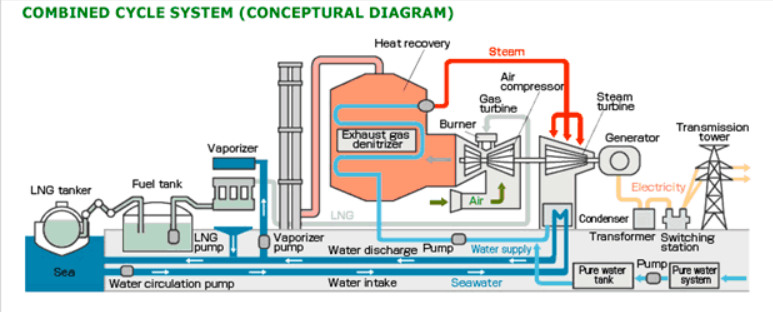The importance of the air-cooled condenser as a key component to achieve efficiencies within combined cycle power plants should not be underestimated.
At the core of CCP plants is the goal of maximizing efficiency through a focus on converting and reusing what would otherwise be waste heat. A goal for which cutting-edge thermal engineering is continuously adding optimizations today.
It’s in this context where the focus on optimizing air-cooled condensing units can be understood, as this piece of the system holds a great potential to improve efficiencies within the plant and, ultimately, increase its final output.
At a time when scrutiny around water use in energy production is growing, along with stricter environmental regulations, air-cooled condensers represent a viable option for CCPPs. In this context, achieving maximum efficiency in air condensing stands out as a key strategy to cut down costs and take plant performance to the next level, while also minimizing its environmental impact. In this article, we take a look at how to achieve this.
Understanding air-cooled condensers in Combined Cycle Plants
The role of air-cooled condensers (ACC)
The air-cooled condensing unit within combined cycle power plants can be understood as yet another piece of equipment that adds a no-waste perspective to these structures.
Specifically, air-cooled condensers are in charge of condensing the steam exiting the steam turbine back into liquid water. In order to do so, the most common approach to ACCs involves employing motor-driven fans to push ambient air through a structure of finned tubes, where the condensation process takes place.
As such, an efficient use of water is at the heart of air-cooled condensers: as opposed to water-cooled systems, they reduce the need for large water withdrawals in order to perform condensation processes.
The key components and their functions in the most common models for air-cooled condensers include:
- A framing structure
- A combination of finned tubes with high thermal conductivity, through which steam is conducted
- Fans, driven by motors and in charge of blowing air through the tubes for steam to condensate
- Condensate collection system
Challenges affecting air-cooled condenser performance
Ambient temperature dependency
At a core level, air-cooled condensers rely on ambient air to remove heat. This means their performance is significantly impacted by ambient temperatures, so that the equipment’s efficiency decreases when temperatures increase. Daily temperature swings, seasonal variations, heatwaves… In such scenarios, ACCs are not able to remove heat as efficiently, resulting in reduced power plant efficiency all together.
While this issue is highly dependent on the power plant location, it can be particularly critical for some structures, considering electrical peak demand tends to coincide with periods when ambient temperatures are at their highest. As such, it represents a significant obstacle to achieve efficiency and is thus important to address as part of optimizing strategies.
Cutting-edge thermal engineering is offering alternatives to address this obstacle through Thermal Energy Storage Systems, as discussed below in this article.
2. Fouling and maintenance issues
Dirt and debris can accumulate on the air condensing surfaces that are linked to heat transfer operations. From dust to pollen, these unwanted materials directly reduce the condenser’s heat transfer rate, with a series of cascading negative effects including reduced power output and increased energy use.
Regular maintenance and cleaning represents the main strategy to reduce the impact of fouling.

3. Mechanical limitations
Linked to the physical components and moving parts of ACCs, these limitations have a direct impact on the system’s efficiency, including:
- Fan damage or incorrect design, which has a direct effect on performance
- Motor wear that reduces fan speed
- Limited motor capacity or flexibility
Key strategies to improve ACC Performance
By looking at the challenges outlined above, a series of strategies emerge as capable of addressing limitations in order to push efficiency. Ultimately, the goal is to enhance the plant’s output while also remaining efficient in terms of energy consumption:
Enhancing airflow efficiency
In this category are a series of strategies that focus on improving how air moves and is distributed around the air-cooled condenser surfaces. This is key because better airflow translates into more efficient cooling: as more air is moved over surfaces, heat can be removed faster, speeding up condensation.
Among these strategies, the following stand out:
- Enhancing fan blades for optimizing air movement
- Improving fan placement for increased air circulation
- Increasing the number of fans
- Applying flexible fan speed control, so that fan operations adjust on demand to match actual cooling needs
- Upgrading fan motors towards more efficient options (so that they deliver more airflow with less power) that also allow for higher fan speed
New thermal energy strategies related to improving air flow have also emerged around the use of Thermal Energy Storage. In this context, TES technologies are employed not to optimize air movement, but to guarantee air is at optimal temperatures. We explore this strategy further below in this article.
Reducing thermal resistance
This set of strategies covers those that recognize the barriers and obstacles that can prevent heat dissipation from happening efficiently. More specifically, these focus on improving surfaces and potential fouling.
Key strategies in this category thus include:
- Choosing materials with great thermal conductivity, such as aluminum, to facilitate heat transfer operations.
- Adopting effective strategies for fouling control by regularly cleaning condenser surfaces.
Advanced control systems
The use of smart control systems represents another key movement to improve air condensing efficiency. The end goal of these strategies is to achieve an alignment between three elements:
- Real-time power plant demand and load
- Ambient conditions
- The system’s performance and operations
In order to do so, intelligent, data-based systems are incorporated to adjust factors such as fan speed or airflow capacities to live conditions, allowing the plant to reach new efficiencies.

TES technologies and their role in air-cooled condensers
The incorporation of TES technologies in air-cooled condensers emerges as a solution that targets the ACCs dependency on ambient air mentioned above in this article.
The term TES covers a range of technologies whose aim is to collect thermal energy for future use. A combination of cooling equipment and energy storage tank, it generates cooling production during off-peak hours to then supply it during peak hours.
As ACCs performance declines with increased ambient air temperatures, TES technologies allow for the stabilization of inlet air temperatures, ensuring that the system remains within optimal operating conditions.
Such an approach was discussed in Venkataramana et al. (2006), which found out “simulations under ambient air temperatures up to 40°C indicated that the proposed system is capable of maintaining the rated net power output of the plant with minimal fluctuations.”
Therefore, adopting this strategy allows air-cooled condensers to maintain peak performance even under higher ambient temperatures, thus preventing the potential fluctuations in power output related to changes in ambient air, as well as the ensuing fluctuations in efficiency.
Design optimization and upgrades for CCPPs: the role of modular design and TIAC
Above, this article has covered the many strategies targeting air-cooled condenser efficiency as a key component to optimize CCPPs output. However, addressing standalone elements within the air-cooled condenser unit is just one of the tactics that thermal engineering puts forward when it comes to enhancing power output.
Below, we present two innovative approaches that reveal further opportunities for enhancement by taking a bird’s eye view CCPPs and the foundations on how to achieve efficiency:
Modular ACC design improvements
Modular ACCs aim at improving overall structure efficiency from a design point of view. This approach involves generating air-cooled condensers composed of a series of self-contained units (the modules) that are individually designed and built. As such, the resulting infrastructure moves away from standardized designs and guarantees a more granular, ad hoc approach for each plant’s requirements. At the same time, because only the needed modules are installed, modular designs involve lower installation and maintenance costs.
When paired with smart systems and monitoring sensors, modular design enhances control in CCPPs, as fan operations are based on temperature and air flow conditions and can be traced back to specific modules. As such, it’s a step forward to be able to adjust power output to actual needs, and towards efficiency.
Turbine Inlet Air Cooling (TIAC)
With turbines at the center of CCPPs, looking at ways of improving their efficiency represents a key opportunity. This is particularly true considering approximately one third of these plants’ output derives from the steam turbine cycle.
As a rule, optimal conditions for a gas turbine are temperatures of around 15˚C temperature and 1.013bar pressure. This represents one of the key limitations when looking at the advantages and disadvantages of combined cycle power plants, as achieving such conditions is an obstacle for many power plant locations.
In this context, TIAC technologies come in to optimize efficiencies by cooling the inlet air entering the turbine to ensure optimal performance irrespective of ambient air conditions.
This cooling process pushes turbines’ performance thanks to allowing for a higher mass flow, resulting in a significant increase in the plant’s power output. In fact, TIAC technologies can push gas turbine power output up to 30%, while also increasing exhaust flow.
At ARANER, we put our thermal engineering expertise to work in order to help CCPPs operators achieve optimal efficiencies.
We develop customized solutions in TIAC technologies that enable both new and retrofit projects to maximize their results.
Looking for ways to optimize power plant efficiency? Get in touch with us and speak to our team of experts about how we can help you.










